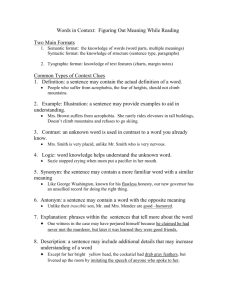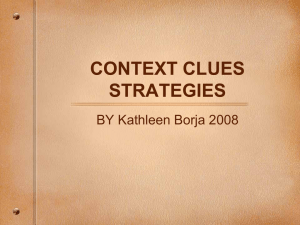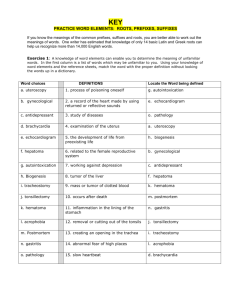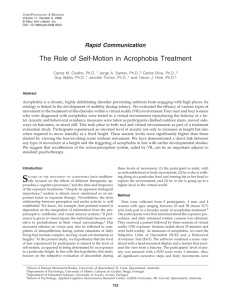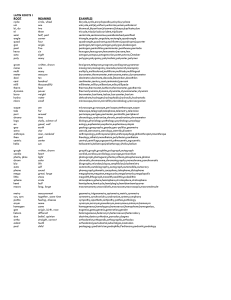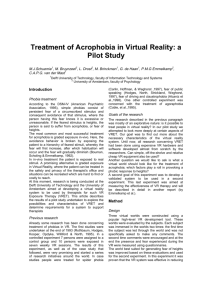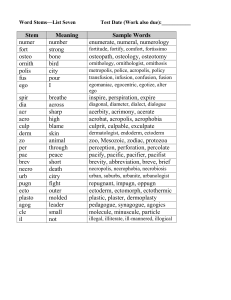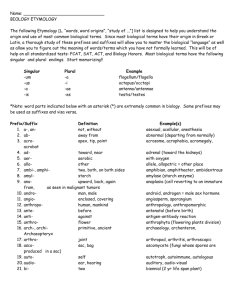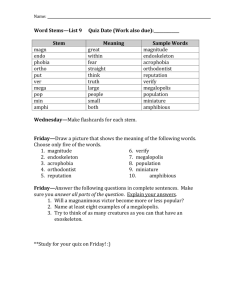part 2
advertisement
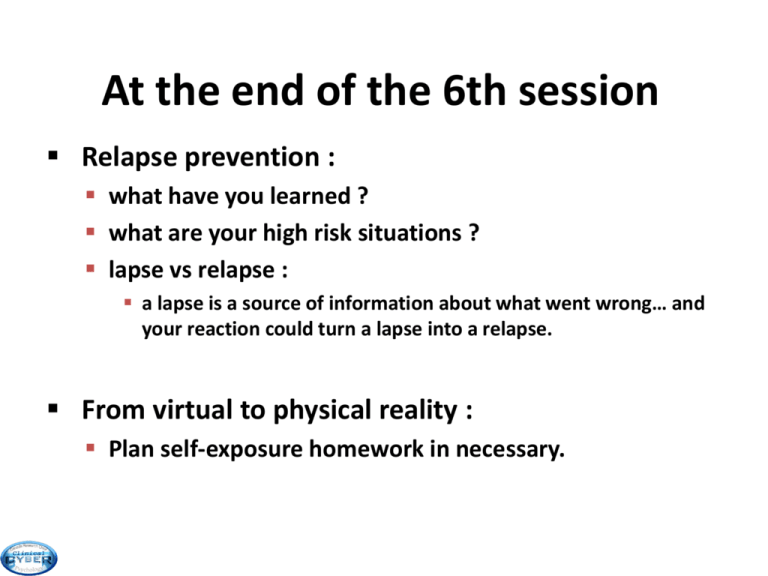
At the end of the 6th session Relapse prevention : what have you learned ? what are your high risk situations ? lapse vs relapse : a lapse is a source of information about what went wrong… and your reaction could turn a lapse into a relapse. From virtual to physical reality : Plan self-exposure homework in necessary. Fostering Presence / Anxiety Talk in «non virtual» terms. «Walk toward the table and then please close the door». Highlight useful virtual stimuli. «Ouch, it’s a big spider… its legs are so long… and its looking at you». «Let the spider walk on the wall behind you». Give the participant some «story line». «Somebody collects spiders in that apartment and we’ll visit it for awhile». Suggest sensations when you talk. «It feels cold in here … bend over if you don’t want to hit your head on the lamp». 1997: Fear of Flying Aviophobia: 30 phobics (Wiederhold BK, Wiederhold MD, 1999) 3 groups VR Exposure with NO physiological feedback VR Exposure WITH physiological feedback Imaginal exposure therapy (VIZ) 2 sessions breathing retraining 6 sessions of exposure # of Participants Behavioral Outcome – 3 month followup 10 9 8 7 6 5 4 3 2 1 0 VR + Physio VR Alone VIZ Flying without meds # of Participants Behavioral Outcome – 3 year follow-up 10 9 8 7 6 5 4 3 2 1 0 VR + Physio VR Alone VIZ Flying without meds VRMC Video Clip: Aviophobia Airport: Side by Side Shots Real Unreal (Tournament) Fear of Flying: Anticipatory Anxiety Controlled Studies: n > 8 Aviophobia Author Country Year # of Pts Tx Grps Wiederhold U.S. 1999 30 VR w/Fdbk, VR no Fdbk, VIZ Rothbaum U.S. 2000 49 PC VR, In vivo, WLC Botella Spain 2002 11 PC VR w/Anticipatory Maltby U.S. 2002 45 VRE, In vivo Wiederhold U.S. 2002 30 VRGETno, VRGETpm, IET Korea 2002 11 Driving vs. Flying Wiederhold U.S. 2002 58 Phobic, non-phobic Rothbaum U.S. 2002 49 VR, SE, WLC Wiederhold U.S. 2003 30 VRGETno, VRGETpm, IET Muhlberger Germany 2003 45 VRCBT, WLC Spain 2004 9 Multiple baseline Jang Botella Controlled Studies: n > 8 Fear of Public Speaking Author Country Year # of Pts Test Groups North U.S. 1998 16 PC VR, WLC Botella Spain 2001 8 Internet-based PC VR Pertaub Harris Slater U.K. U.S. U.K. 2001 2002 2004 43 14 40 Phobic, non-phobic VRT, WLC Phobic, non-phobic People React to Avatars’ Behaviors (Pertaub, Slater, & Barker, 2001, 2002) Static audience Subjects : 43 fear of public speaking patients - Randomly assigned to one of three groups, distinguished by the type of virtual audience - Subjects have to talk in front of the virtual audience, at least twice. Positive audience Scenario : 8 formally dressed avatars, seated around a table Three variables : 2 designed to assess the degree of selfreported anxiety generated by experience The other to measure the speaker’s assessment Negative audience of their performance. (With a modified form of the Personal Report of Confidence as a Speaker - MPRCS) Pertaub, Slater & Barker (2001, 2002) Satisfaction towards the performance 14 12 MPRCS 10 8 6 4 2 0 Neutral Positive Negative Type of audience ANCOVA (estimated from data in the paper) Type of audience, p < .05 Negative > positive = neutral. 100 90 80 70 60 50 40 30 20 10 0 Neutral Positive Negative Type of audience Anova Type of audience, p < .05 Neutral > Positive = Negative, p < .05 Public Speaking Virtual Environment Controlled Studies: n > 8 Needle Phobia Author Country Year # of Pts Hamza South Africa 2000 16 Test Groups Needle phobic Virtual Environment Polar view of the layout of the virtual student health Virtual Scenario Simulation of a doctor’s appointment Two types of exposure to the injection Injection lying on the further end of the doctor’s desk Simulation of the injecting procedure: Doctor applies a virtual swab to the avatar's arm and injects the needle Heart Rate at Various Stages Highest Mean heart rate is when the injection is moving closer to the arm (i.e., situation INJ2 = 95.08 beats per minute) 140 120 100 Mean Heart Rate Decrease in heart rate in INJ3 Mean Heart rate for the first 6 situations did not vary much 80 60 40 Desk2 ArmUp INJ1 INJ3 Desk1 Desk3 Swab INJ2 Various Stages SUDS at Various Stages • As patients moved closer to the needle, mean SUD increased • Mean SUDS decreased between when the patient has raised his/her arm and after swab is applied 5.17 8 4.6 7 6 6.0 5.71 5.05 4.41 4.5 3.65 5 Mean SUDS 4 3 2 1 Desk1 Desk3 Swab INJ2 Desk2 ArmUp INJ1 INJ3 Various Stages Scripps Clinic Movie Clip Controlled Studies: n > 8 Acrophobia Author Country Year # of Pts Hodges, North U.S. 1995 17 SG VR, WLC Lamson U.S. 1995 9 SG VR, WLC Bullinger Switzerland 1997 8 SG VR, In vivo U.S. 1998 10 CAVE, In vivo Emmelkamp Netherlands 1999 10 PC VR, In vivo Emmelkamp Netherlands 2002 33 PC VR, In vivo Emmelkamp Netherlands 2002 37 PC VR , CAVE, WLC Canada 2002 8 Videogame VR U.S. 2004 30 Stroop Physio, VR Physio, In vivo Huang Bouchard Sirbu Tx Grps Virtual Reality Research Set-up Physiological Differentiation in Participants with High and Low Fear Scores Exposed to a VR Heights Environment (Wiederhold, Wilhelm, Nguyen, Kim, & Gross) Protocol Participants stood on a platform in a darkened room 5-minute baseline Viewed neutral film through HMD 15-minute VR exposure Post-exposure, participants completed self-report questionnaires to identify a number of physiological sensations and emotions Acrophobia: Fear of Heights Measures Self-Reported Anxiety HR: Heart Rate MAP: Mean Arterial Blood Pressure FPA: Finger Pulse Amplitude FPTT: Finger Pulse Transit Time EPA: Ear Pulse Amplitude EPTT: Ear Pulse Transit Time TEMP: Peripheral Skin Temperature SCL: Skin Conductance Levels RR: Respiratory Rate TV: Tidal Volume ACT: Somatic Activity Acrophobia: Fear of Heights Self-Reported Anxiety 8 High Acrophobia Anxiety Rating (0-10) 7 Low Acrophobia 6 5 4 Heart Rate 3 2 100 1 High Acrophobia 0 0 2 4 6 8 10 12 Low Acrophobia 95 14 Minute SUDS = 0-10 Heart Rate 90 85 80 75 70 0 2 4 6 8 Minute 10 12 14 Acrophobia: Fear of Heights 12 High Acrophobia Skin Conductance Low Acrophobia 11 10 SCL 9 8 7 6 5 0 2 4 6 8 10 12 14 Minute Desynchrony/Discordance: HR & Self-Report 8 100 High Acrophobia High Acrophobia Low Acrophobia Low Acrophobia 95 6 90 5 Heart Rate Anxiety Rating (0-10) 7 4 3 85 80 2 75 1 0 70 0 2 4 6 8 Minute 10 12 14 0 2 4 6 8 Minute 10 12 14 Acrophobia: Fear of Heights Synchrony/Concordance: Skin Conductance & Self-Report 8 High Acrophobia Low Acrophobia 6 12 5 11 High Acrophobia 4 Low Acrophobia 10 3 SCL Anxiety Rating (0-10) 7 2 9 8 1 7 0 0 2 4 6 8 Minute 10 12 14 6 5 0 2 4 6 8 Minute 10 12 14 Acrophobia: Fear of Heights High Acrophobia Low Acrophobia 100 95 Ear Pulse Transit Time 90 220 85 High Acrophobia Low Acrophobia 215 80 0 2 4 6 8 10 12 14 Minute Mean Arterial Blood Pressure 210 EPTT Mean Arterial Blood Pressure 105 205 200 195 190 0 2 4 6 8 Minute 10 12 14 Acrophobia: Fear of Heights Summary Results Increased: Self-reported Anxiety Blood pressure Skin conductance Somatic activity Respiration rate (both) Decreased: Ear pulse transit time (indicative of greater sympathetic activation) Heart Rate (result of compensatory changes driven by the blood pressure changes?) Acrophobia: Fear of Heights Side by Side Pictures Real Virtual Reality Acrophobia: Fear of Heights Acrophobia: Cable Car
